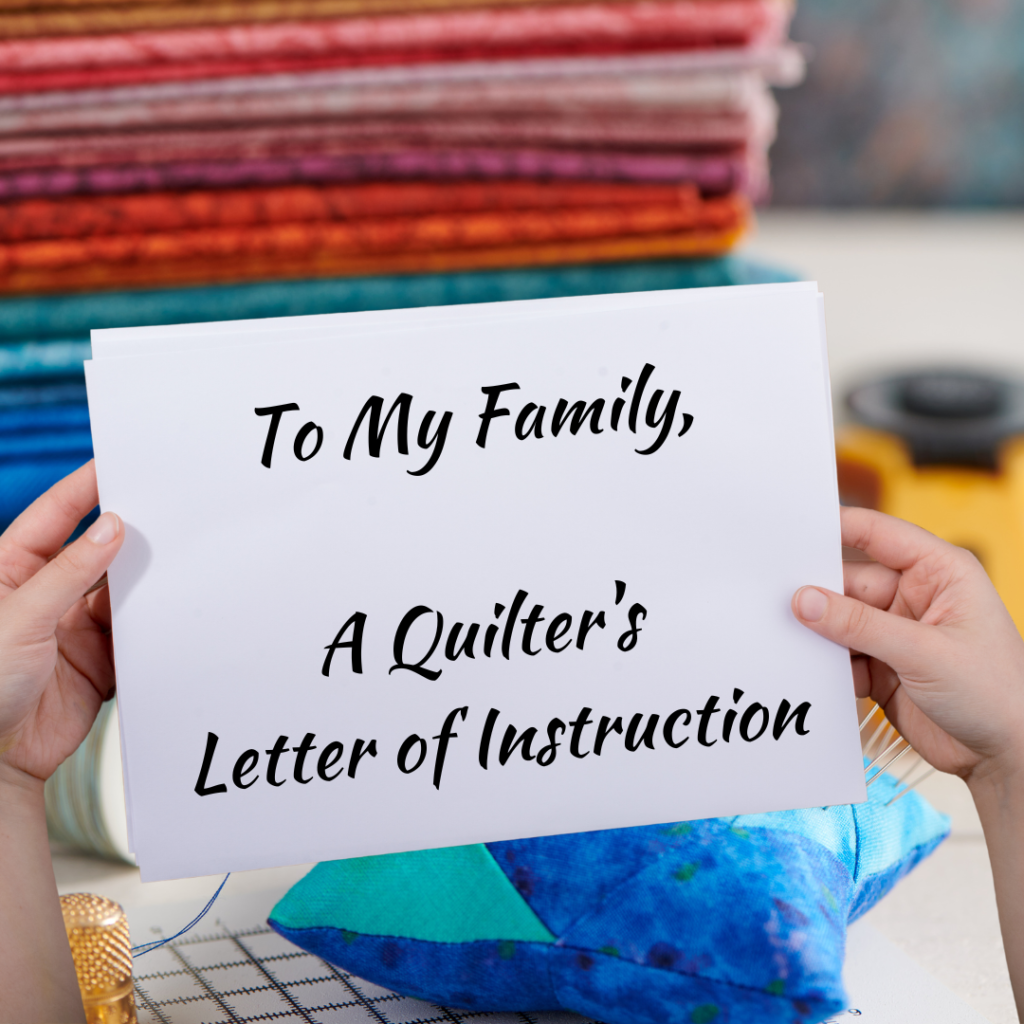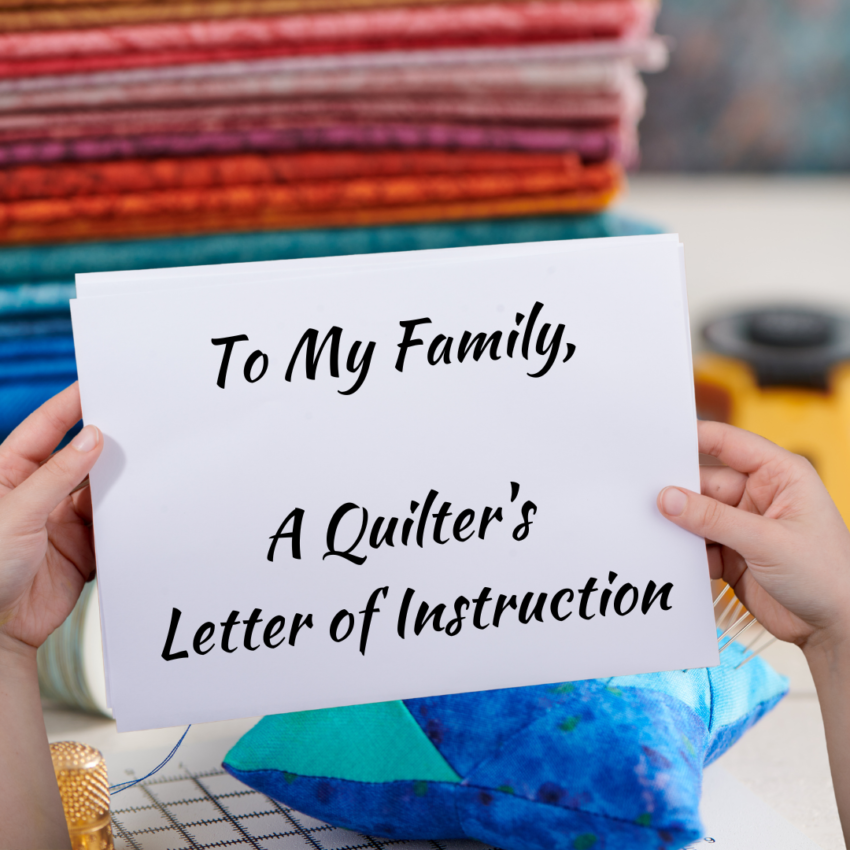
One day – it will be that day. Your loved ones will wonder what you would have wanted them to do with all your cherished quilting/sewing/crafting supplies, tools, equipment, and projects (finished or not).
Perhaps you’ve already had some experience with this yourself, I know I have. Twice. Over the course of a few short years, I lost two very close friends. Both were quilters and crafters. In both cases, I knew what they wanted to have done with the contents of their sewing/crafting spaces – because we had talked specifically about it. It fell to me to help their spouses and family carry out their wishes.
What if we hadn’t had those conversations? Would their family know who to ask for help? Do you know what you would tell them if they did ask?
Every family and every situation is different – one thing remains the same. As creative people – we pour out heart and soul into the things we create and the materials and tools we use to do that creating. We’ve made significant investments in our craft. I’m guessing that like me – you would wish that those things that mean so much to us – go to good use, rather than being unloaded at a garage sale or tossed in a box and dropped off at a charity’s collection point.
In my small quilt group – we’ve talked about this concern many times over the years. What would happen when the inevitable happens – and most of us have a plan. Often that plan involves calling someone else in the group to help with the task. I’ve taken a more formal approach with a letter of instructions – spelling out what I want to happen with all my quilty treasures. My family won’t need to wonder what I want them to do – they have it in writing.
First of all – I’m not providing legal advice of any kind. If you have questions of a legal nature – please contact your legal advisor.
That being said – “A Letter of Instruction” really starts with a series of questions you want to ask yourself. The answers to those questions are what you would include in a letter you would make known to your loved ones, so they understand your wishes. That sounds good – how do you go about creating a letter of instructions? So glad you asked ; )
Simple Instructions – or a more detailed Letter of Instruction
How detailed you want your letter to be is completely up to you. Just know that if you don’t provide any kind of guidance for your loved ones – it will make the process more difficult for them to carry out. You may feel that – “When I’m gone, they can do whatever they want with it” – that’s perfect if that’s what you want. On the other hand, you may feel strongly about where some items go and what you want to be done with the rest of your quilty treasures – also perfect. There are no right or wrong answers to these questions – only your preferences.
Getting Started
I think it’s important to break the process down into bite-sized chunks. Let’s take a look at those questions.
- Do you want to designate one (or more) person to carry out your instructions?
- Are there specific items you would like someone specific to have?
- Is your preference that your items be sold or donated – or a combination of the two?
- Machines and Tools: Do you have specific machines or tools that you want to leave to a particular person? List them by item and person(s) name(s).
- Finished Projects and Quilts: Do you have quilts or other finished projects that you want someone to have? List them by item and person(s) name(s).
- Unfinished Projects: Do you have a preference for what should happen with your unfinished projects? Make note of what you would like to happen to your unfinished projects (gift, donate, etc.).
- Fabric Collection: Do you want any part of your collection to be given to someone in particular – list them and describe what you want them to have. Make note of where you want the remaining fabric collection to go.
- Patterns and Books: Do you want any of these items to go to specific people? If so, make a list of those items and to whom you want them to go.
- Thread and other Notions: Do you have a large collection of threads and notions?
- Craft Items: Describe what those items are, where they are located, and what you would like your family to do with them.
- Everything else: Provide specific instructions for rehoming any remaining items. This could include donating them, selling them, or giving them away to another quilter or crafter.
- Donations: Do you want anything to be donated to a specific organization? If so, what do you want to donate – and what organization would be receiving the donation?
- Online Quilt Groups: If you belong to any online quilting communities, list them and how you want those groups to be notified.
- Quilt Guilds or small quilt groups: List them and how you want those groups to be notified.
One final question to consider – Do you have strong feelings about anything that you don’t want to have happen with your quilting and crafting collection? If you do – be sure to spell it out in your letter.
Sample Letter of Instruction
This sample letter hits a middle ground between a very simple direction to family and something much more detailed. Ok – to be honest – it does skew a bit more detailed – that’s how I’m wired ; )
Dear Beloved Family,
As I cherish my time spent in the world of quilting, I want to ensure that my quilting treasures and projects are handled with care and respect after I am no longer here. These pieces hold special memories and a piece of my heart, and I hope that my creative legacy can bring you comfort and joy in the days and years ahead.
To assist you in managing my quilting legacy, I’ve prepared this letter with some guidance:
Inventory and Organization: Please take note of the tools, notions, patterns, and fabrics that are most essential to my quilting. My sewing space and storage areas are organized to facilitate creativity, so I hope that as you go through my things – you will keep things as organized as possible.
Disposition of Projects: Some quilts are intended as gifts for specific individuals; I have listed their names and the quilts accordingly. If there are unfinished projects, consider whether to complete them or pass them along to fellow quilters who share my passion. If you are unsure – please contact [Name of quilting friend and contact info] for guidance.
Sewing Machines: I have the following sewing machines – [List]. These machines should be [Describe what you want to have happen with each machine].
Fabric, notions, thread: I would like for these people [Name(s] to go through my fabric collection and select any items that they would enjoy using. All remaining fabrics, notions, and thread should be donated to [Name of Organization].
Documentation: You might find notes, sketches, or instructions for ongoing or future projects. Please keep these notes with the materials for the project they go with. Notes for any future project I haven’t explored can be [describe here].
Local Quilting Community: I am part of any quilting groups [Name of group – and how to contact] and/or guilds [Name of Guild and how to contact them], please notify them of my passing and express my gratitude for their companionship.
Legacy Projects: Should you feel inspired, completing any unfinished projects in my honor would warm my heart. Consider showcasing my work at quilting events or contests, allowing my passion to live on.
Digital Presence: If I have an online quilting presence, kindly manage those accounts in a way that aligns with my values and wishes.
Donations and Disposal: Any quilting supplies, books, or tools can find new homes among those who share my enthusiasm. If there’s anything unsuitable for donation, dispose of it responsibly.
Personal Messages: I may have messages or letters for my quilting friends and family, expressing my gratitude and love. [Describe where these messages can be found]. Please ensure these are delivered.
Preservation of Memory: As time goes on, consider ways to celebrate and honor my quilting legacy. It might be through exhibitions, donations, or even teaching others the art that has been such an important part of my life. Even more importantly – please share your stories about my quilting legacy with future generations of our family.
Thank you for being a part of my life and embracing my passion for quilting. Your support has meant the world to me. May my quilts continue to bring warmth and happiness to your lives.
With love and gratitude,
[Your Name]
Donation Options
I love the idea of donating quilting and crafting items to places where they can inspire others to create, learn new skills – and make things. If those materials can be used to honor someone, ease a painful moment, or make a difference in someone’s life – even better. Here are a few ideas – and places I’ve donated to. There are most certainly others in your community – it just takes a bit of searching.
- Quilts of Valor
- Linus Project
- Passage Quilts – usually associated with a local hospital
- Local 4H programs
- Scouts or Campfire Programs
- Local Quilt Guilds
- Quilting Programs in the local women’s prison
- High School or College Theater Arts programs
At the End of the Day
You can think about what you would want your family to do with all your quilting treasures – and choose to put off letting them know. On the other hand, you could take a few minutes, consider the list of questions I’ve mentioned earlier and write that letter. Make it as simple or as detailed as you like – it’s up to you.
Sharing the Letter
If you do write that letter – it’s important to put it where your loved ones will be looking for it. My recommendations:
- Put a copy with all your other important papers,
- Share it with your immediate family
- A friend I know has her posted on the back of the door into her sewing space. I love this idea ; )
The links below will open a copy of the Sample Letter as well as the List of Questions that you can print out and modify for your own needs.
A Quilter’s Letter of Instruction – Sample Letter
A Quilter’s Letter of Instruction – List of Questions

